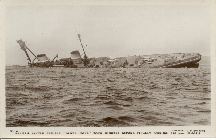At Scapa Flow a German battleship was sunk during WW1 and the London, Liverpool Salvage Co. had enough technical know how to raise it and have it towed to the Port. It was the 'Derflinger' and was upside down. Divers spent weeks cutting away superstructure to get her on the floating dock, but after they had done as much as they could, the dock would have to sink one and a half feet below the design specifications. The Captain, quite rightly, was worried about this turn of events and related them to my mother. It worked out, and it was said that the rare (at that time) metals in 2 or 3 propellers would pay for the whole salvage operation including raising and towing. I think there were two props for each of the two shafts. It was a great success for all.
It seemed to me in those days that the main idea in the Army was to get you as fed-up as possible, so that you welcomed any change. They caught us in this mood when orders came to embark for Gallipoli; so lustily we sang all the way from Cairo to Alexandria, sitting in cattle trucks, regulating the beat of the song to the clip of the wheels.
At Alexandria, after hours of delay, we embarked on a captured German liner, the Derflinger. Iron plates above, iron plates below, and riveted iron plates each side, bordered our bedroom. Closed and covered portholes kept out light and air, the darkness being partially relieved by a few electric globes in cages.
In this half-light confusion attended the hanging of our hammocks as we tripped and fell over bits of unfamiliar ship's tackle. All this appeared more ridiculous when we slept on deck owing to the heat down below. We slept as we were. Nobody thought of undressing.
For three days and three nights four men lived where one would have been cramped in that iron-cased floating stink-hole, eating badly-cooked food and drinking warm water. By the night of the third day, as we neared Gallipoli, we were in the mood for anything. We'd fight anybody for anything; we didn't care what.
Gallipoli
On 3 May, 1915 the Manchesters boarded the Derflinger. This was a captured German vessel which had only arrived in Alexandria a few hours before carrying over 500 casualties from the fighting.
Derfflinger built1908. 1914 seized by Britain, renamed Huntsgreen, 1923 repurchased by NGL reverted to Derfflinger, 1932 scrapped. 9,060 tons.
The DERFFLINGER was a 9060 gross ton ship, length 463ft x beam 57.7ft,
one funnel, two masts, twin screw, speed 14 knot. Accommodation for
104-1st, 104-2nd and 1,919-3rd class passengers.
Built by F. Schichau, Danzig, she was launched on 9th Nov.1907 for
North German Lloyd, Bremen and started her maiden voyage from Bremen
to New York on 9th May 1908. After this voyage, she was used on the
Bremen - Suez - Far East service until 1914 when she was captured by
the British at Port Said. Renamed HUNTSGREEN and operated as a
troopship, she was re-sold to NGL in 1923 and rebuilt to 9162 gross
tons, with accommodation for 290-2nd and 521-3rd class passengers. She
resumed Bremen - New York sailings on 20th Sep.1923, and later
Bremen - Halifax - Galveston voyages. Her last Bremen - Halifax -
Galveston sailing was on 3rd May 1928 and she subsequently returned to
the Far East service until 1932 when she was scrapped at Bremerhaven.
[North Atlantic Seaway by N.R.P.Bonsor, vol.2] [Norddeutscher Lloyd
Bremen, by Edwin Drechsel, vol.1]
The Welch/Welsh Regiment, Gallipoli.
Devonport sailing east to Alexandria, 17th July 1915."SS Huntsgreen" The voyage east was uneventful, with the exception perhaps, of the list which developed as a result of being so hurriedly despatched as to allow no time for the cargo to be properly stowed.
No shore leave in Alexandria was given and the ship proceeded to Port Said.
SS " Huntsgreen" accompanied by other transports steamed for the Gallipoli Peninsula, where she arrived on the 5th August 1915 being the day on which the original Suvia bay landing was made.
Hope this helps Moira.



